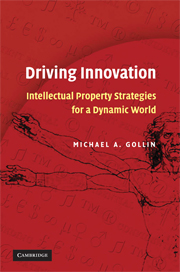Book contents
- Frontmatter
- Contents
- Foreword
- Preface
- Acknowledgments
- Abbreviations
- Introduction: The Invisible Infrastructure of Innovation
- PART I INTELLECTUAL PROPERTY DYNAMICS IN SOCIETY
- PART II BASICS OF MANAGING INTELLECTUAL PROPERTY IN ORGANIZATIONS
- PART III STEPS TO STRATEGIC MANAGEMENT OF INTELLECTUAL PROPERTY
- 8 Becoming Strategic
- 9 Strategy Tools: Policies and Practices for Managing Intellectual Property
- 10 A Menu of Strategy Options
- 11 Evaluating Internal Resources and the External Environment
- 12 Placing a Financial Value on Intellectual Property Assets
- 13 Accessing Innovations of Others
- 14 Acquiring and Policing Intellectual Property Rights
- 15 Doing Innovation Deals
- PART IV STRATEGIES ON A GLOBAL STAGE
- APPENDIX A Excerpts from TRIPS Agreement
- APPENDIX B Intellectual Property Non-Policy
- APPENDIX C Intellectual Property Assessment Questionnaire
- APPENDIX D Research Tools for Obtaining Intellectual Property Information
- Bibliography
- Index
14 - Acquiring and Policing Intellectual Property Rights
Published online by Cambridge University Press: 05 June 2012
- Frontmatter
- Contents
- Foreword
- Preface
- Acknowledgments
- Abbreviations
- Introduction: The Invisible Infrastructure of Innovation
- PART I INTELLECTUAL PROPERTY DYNAMICS IN SOCIETY
- PART II BASICS OF MANAGING INTELLECTUAL PROPERTY IN ORGANIZATIONS
- PART III STEPS TO STRATEGIC MANAGEMENT OF INTELLECTUAL PROPERTY
- 8 Becoming Strategic
- 9 Strategy Tools: Policies and Practices for Managing Intellectual Property
- 10 A Menu of Strategy Options
- 11 Evaluating Internal Resources and the External Environment
- 12 Placing a Financial Value on Intellectual Property Assets
- 13 Accessing Innovations of Others
- 14 Acquiring and Policing Intellectual Property Rights
- 15 Doing Innovation Deals
- PART IV STRATEGIES ON A GLOBAL STAGE
- APPENDIX A Excerpts from TRIPS Agreement
- APPENDIX B Intellectual Property Non-Policy
- APPENDIX C Intellectual Property Assessment Questionnaire
- APPENDIX D Research Tools for Obtaining Intellectual Property Information
- Bibliography
- Index
Summary
This chapter presents a first decision tree approach for protecting innovations with IP rights, and a second one for enforcing them. The process begins with the internal innovations identified in the screening step in Chapter 13. Next comes innovation triage, sorting innovations according to their value to the organization and the urgency of protecting them. The next step is a methodical approach to making decisions about protecting individual innovations as IP assets, with specifics for protecting tradesecrets, copyright, trademarks, and patents. A similar approach is described for managing a portfolio of existing IP assets. The second part of the chapter describes enforcement and policing an organization's IP rights against infringement by outsiders, including a process of enforcement triage for each type of IP asset.
PROTECTING INNOVATIONS FROM INSIDE THE ORGANIZATION
When screening innovations that are important to the organization, the first step is to identify where the innovation comes from. We turn now from innovations that come from outside the organization to the task of protecting and enforcing innovations that come from inside the organization.
For innovations created by insiders (that is, people under an obligation to transfer their innovations to the organization, people such as employees and consultants under appropriate contract), the next series of decisions go toward protecting the innovation with IP rights. If an innovation was created by the combined efforts of insiders and outsiders, it may be desirable to break down the innovation into smaller parts, some from inside and some from outside, and deal with the rights that way.
- Type
- Chapter
- Information
- Driving InnovationIntellectual Property Strategies for a Dynamic World, pp. 239 - 262Publisher: Cambridge University PressPrint publication year: 2008

